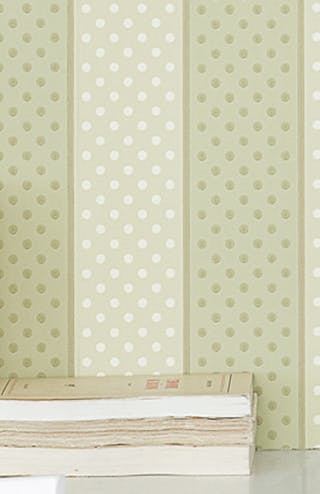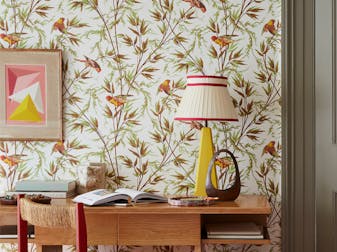
Archive Wallpaper
Elephant Stripe c. 1850
Taking the exact proportion and structural quality of the Broad Stripe, each band in this more complex version comprises 42 ‘pin stripes,’ creating a sharper, more contemporary look that appeals at first glance and offers more on closer inspection. Given its finer proportions, this design would have been virtually impossible to print before the arrival of the print roller in around 1850.
Colonial Stripe c. 1840
The original wallpaper that inspired this design, found at a property in Carlisle Street in Soho, London, is actually a much more complex pattern than the design we have extracted from it. By removing the solid stripes and extraneous leaf trail, we are left with a wallpaper that achieves all-over pattern and an elegant stripe at the same time.
Tented Stripe c. 1845
Originally produced as a design on fabric, the larger scale production of this classic 19th Century stripe was a natural development from the early 'open trough' printing method referred to in ‘Broad Stripe’. Its name is taken from the Regency fashion of hanging fabrics in a room to create a 'tented' effect. The proportion of the elements within these stripes was typically fairly consistent, but the scale on which they were reproduced (and used) varied considerably. Having been shown extensively in its own right as a stripe, the design was subsequently popularised as a background to a range of larger overprinted designs, including French damasks.
Cavendish Stripe c. 1965
In keeping with its sister wallpaper ‘Marlborough’ from our London Wallpapers II collection, the age of the paper on which this design is based is perhaps misleading in terms of its provenance. Dated at 1965, this particular fragment emerged during restoration work at Marlborough House on Pall Mall, London, though this paper in itself was based on an original from much earlier. In our interpretation, the motif – in fact a flock – has been completely removed to leave a cleaner, more versatile stripe.
Ombre Plain c. 1956
Very much a twentieth century design, this is a 1950’s English pattern found at the Whitworth Art Gallery in Manchester. A band of fine, single colour white stripes over flat ground(s), it's in fact the space between stripes that creates the subtle optical movement. The more complex striped versions contain an additional three ground colours each, and the plain versions are produced in matching colourways to specifically coordinate with the different elements of the stripe, offering a highly flexible range of papers to be used in combination in traditional and contemporary homes alike.
Ombre Stripe c. 1956
Very much a twentieth century design, this is a 1950’s English pattern found at the Whitworth Art Gallery in Manchester. A band of fine, single colour white stripes over flat ground(s), it's in fact the space between stripes that creates the subtle optical movement. The more complex striped versions contain an additional three ground colours each, and the plain versions are produced in matching colourways to specifically coordinate with the different elements of the stripe, offering a highly flexible range of papers to be used in combination in traditional and contemporary homes alike.
Maddox Street c. 1810
A classic Regency Stripe, which was recovered from the oldest surviving terrace house in Maddox St, Mayfair, a property built around 1715. The paper was found in the second floor front room, most likely used as a bedroom; it was the oldest paper in a ‘sandwich’ of no fewer than 17 layers and dates to around 1810 or possibly even slightly earlier.
Carlisle Street c. 1890
The original wallpaper that inspired this design, found at a property in Carlisle Street in Soho, London, is actually a much more complex pattern than the design we have extracted from it. By removing the solid stripes and extraneous leaf trail, we are left with a wallpaper that achieves all-over pattern and an elegant stripe at the same time.
Paint Spot c. 1830
A faithful reproduction of an historic French wallpaper. Perhaps surprisingly, the original hails from 1830 and was printed in a bold combination of yellow and pink. Particular attention is paid to the paint reticulation (also known as the seaweed effect) evident within the printed spot element, in giving orientation – there is a right way up and wrong way up for this paper to be hung.
Tailor Stripe c. 1968
Another Twentieth Century stripe, each of these papers contains a judicious balance of six tightly packed colours, giving each an overall theme and several opportunities for picking out painted walls and trim. Inspired by the way designers would 'tag' colours together in referencing interior design schemes, and inherently close to the way colours were handled by fashion.
Thames Border c. 1851
Faithfully reproduced, but increased in scale, from a fabulous piece, this historical Panorama of the capital was published by London Illustrated News in 1851. This hand drawn, hand painted scene depicts the buildings and landscape along the river Thames at the time and has been remastered to include a repeating section meaning it can be hung on any size wall. The original would have been shown at cornice height, but in rooms of a more normal scale, it has been created to sit comfortably at dado or skirting height as well.
Broad Stripe
A classic ‘Roman’ or Regency proportion stripe originally produced in the 18th Century using the ‘open trough’ method, in which the stripes were created by bands of paint seeping through holes or slots in the bottom of a wooden trough, onto the surface of the paper as it was pulled beneath. Striped wallpapers manufactured in this way are characterised by a brushed finish which was later superseded by a flatter print achieved with 19th Century rollers, as is evidenced in these papers. The grand scale of this particular stripe is tempered by the restricted use of colour – in each case the stripe sits on a softer ground of the same hue, creating a wallpaper that brings a relaxed structure to a room, without being too formal.

Help with Wallpaper






































